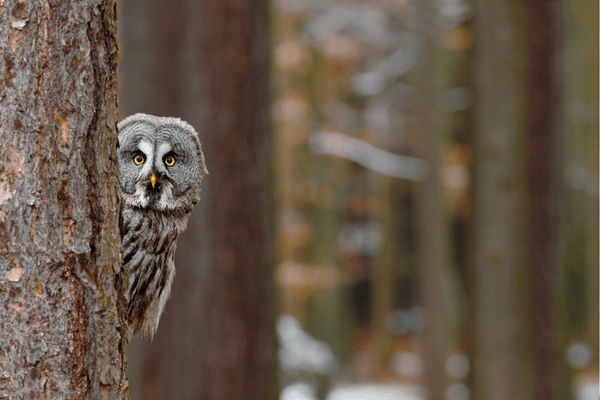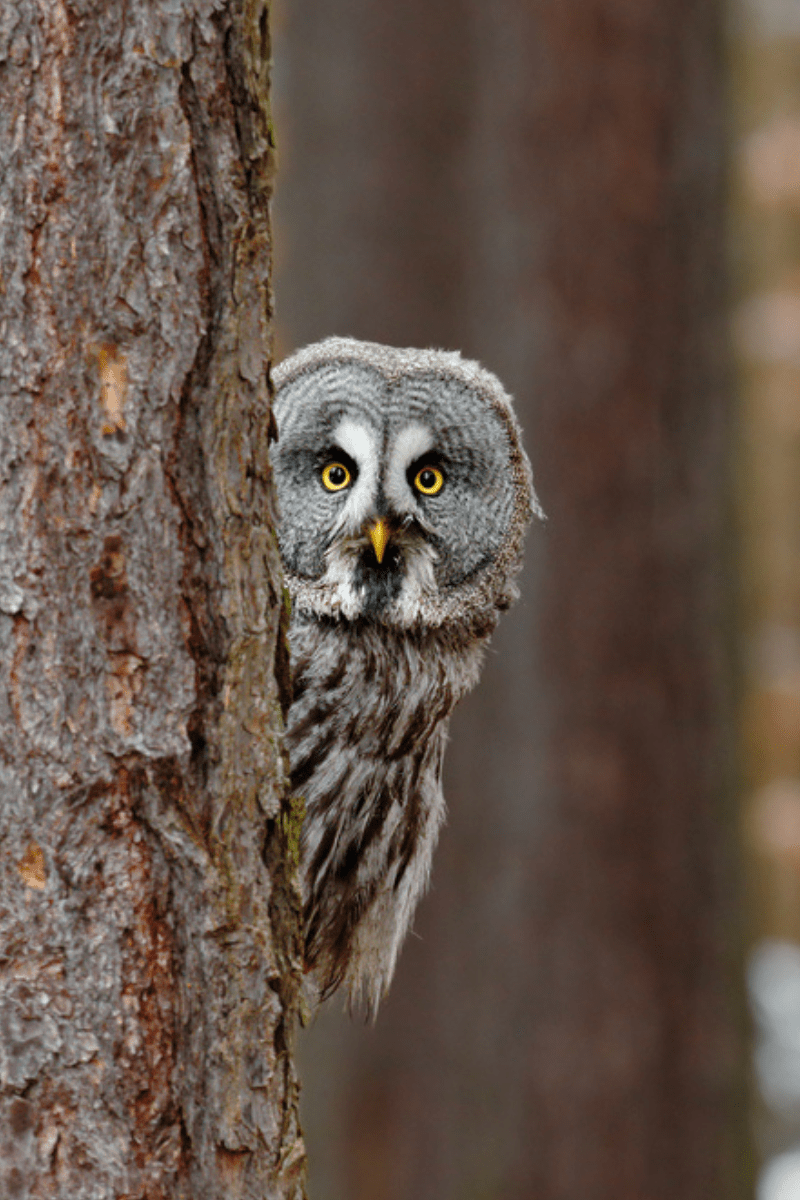Contents
The Great Grey Owl, otherwise known as Strix nebulosa, is a very popular bird that goes by many other names. Some other popular options include the Great Grey Ghost and the Phantom of the North.
For the most part, the Great Grey Owl can be mostly found nesting in dense boreal forests in the North throughout Eurasia and North America. Typically speaking, in the Pacific Northwest, you’ll find them in the Klamath Mountains and the northern Rocky Mountains.
Are you trying to find out as much information as possible about Great Grey Owls? I’ll share the full breadth of my wisdom and knowledge with you today. The topics I’ll cover include:
- The right way to identify a Great Grey Owl
- Differences in physical characteristics between males and females
- Great Grey Owl fun facts and other information
- Migratory, nesting, feeding, behavioral, and dietary habits and preferences
- Other interesting facts and more
Continue reading to learn more about the Great Grey Owl.
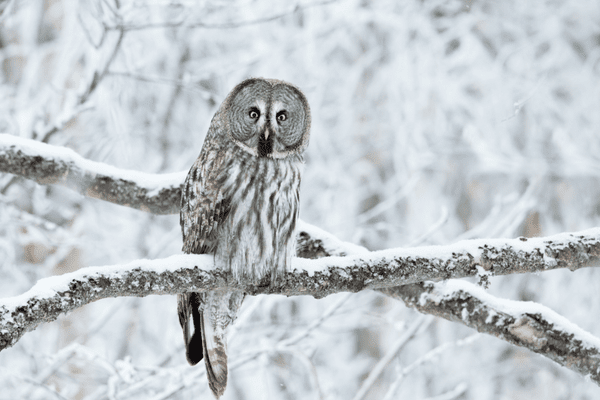
Great grey owl facts
- Common Name: Great Grey Owl
- Scientific Name: Strix nebulosa
- Scientific Family: Strigidae
- Life Span: 15 years
- Size: 24.0 to 33.0 inches
- Wingspan: 55.0 to 56.0 inches
- Weight: 20.48 to 67.04 ounces
- Conservation status: Least Concern
Great grey owl: how-to identify
The easiest way to identify a great Grey owl is to know that its color pattern is silvery gray all over its body. And their pattern possesses feet barring including brown, gray, and white streaks. They also have a facial disc that is made up of brown and gray concentric circles and they possess bright yellow eyes that shine at night.
Differences Between Male & Female
Out of all of the owls in existence today, the Great Grey Owl is considered one of the tallest, it has one of the longest tales, and it also has one of the broadest wingspans.
Oddly enough, they are much larger than just about every other owl and they have big heads and large facial discs, but they do not weigh too much since most of their bulk is made up of feathers.
There’s only one main difference between female and male Great Grey Owls. And that difference is the size, my friends. The female Great Grey Owl is larger than her male counterpart.
Differences In Summer Plumage vs Winter Plumage
There doesn’t seem to be much of a difference between summer and winter plumage when it comes to Great Grey Owls. Although, as the Great Grey Owl ages, you’ll discover a much bigger selection of brown feathers mixed in with the gray.
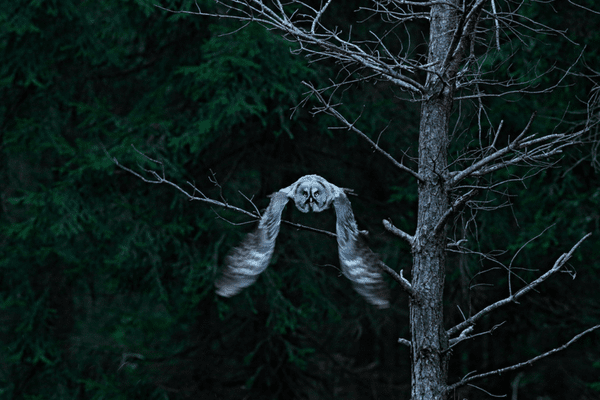
Where You’ll See Great Grey Owls
Great Grey Owls have a wide range but they are known to breed in North America by going as far east as Québec in Canada. They’ll also range to the Alaskan Pacific Coast and across northern Asia from Estonia and Finland.
These aren’t migratory birds so they become permanent residents of the spaces that they take up. Although, when food is scarce, the northerly populations will often begin moving further southeast or south in an effort to find more food.
Typically, the population remains sedentary in the states in the Pacific including Washington, Oregon, and California.
Great grey owl bird migration
The Great Grey Owl is very similar to the snowy owl because it doesn’t actually migrate. More often than not, it will remain within its normal range, but it does travel outside of it on occasion if it’s running low on food.
Ideally, these large owls prefer large spaces close to meadows or taiga in the midst of dense forests of deciduous or coniferous design.
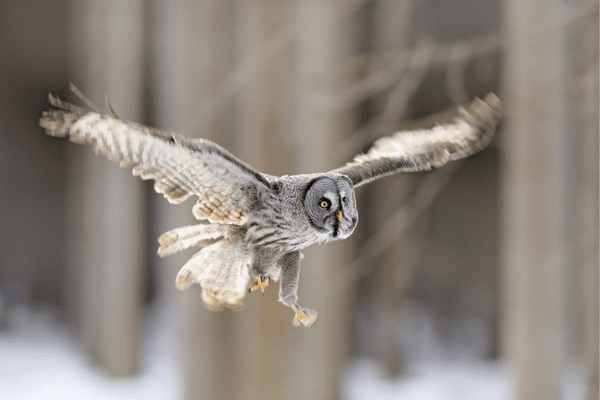
Great grey owl diet
Like most owls, the great Grey owl is also a carnivore and small rodents make up the majority of its diet. In truth, they’ll eat just about any small mammal that they can find. Typically, they’ll eat whatever is most abundant in their territory.
For the most part, you’ll find Great Grey Owls Feasting on a wide variety of animals including ducks, mountain quail, hares, pocket gophers, lemmings, weasels, grouse, Canada jays, shrews, moles, small hawks, voles, thrushes, rats, and mice.
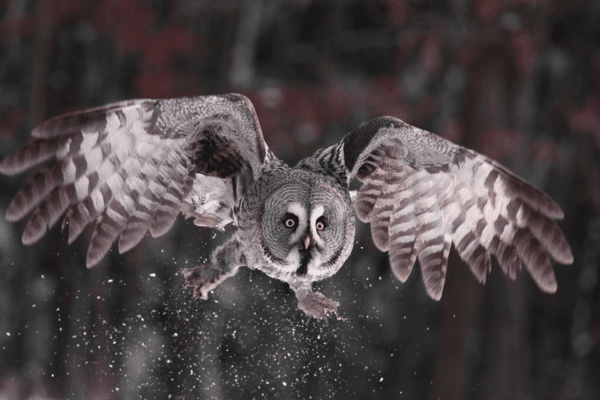
Great grey owl nesting
- Clutch Size: 2-5 eggs
- # of Broods: 1 brood
- Incubation Period: 28-36 days
- Nestling period: 26-29 days
- Egg Description: Dull White
Very similar to other owls, the great Grey owl does not build its own nest. More often than not, they will take over common raven nests or old raptor nests and make them their own. On occasion, they’ll even take over the nest of the western gray squirrel.
The difference between great grey owls and other owls is they don’t add extra material to the nest like burrowing owls or screech owls as examples.
Finally, when a female great grey owl lays eggs, she will place them atop dead trees, mistletoe clumps, or man-made platforms.
Great grey owl behavior
For the most part, the Great Grey Owl is a nocturnal creature so it mostly remains active at night. But it does hunt and do other things before dawn or right at dusk. And during the breeding season, it’s certainly possible for the great Grey owl to remain active during the day.
As these birds fly, they have very slow and soft wing beats. It glides seldomly, and when the owl does fly, it usually only moves in very short distances from one perch to another.
Great Grey owls also like to remain very close to the ground while flying. They typically stay merely 20 feet off the ground or less. The only time they will fly higher is when they are flying to a high nest.
Typically, the great Grey owl is a very docile creature and it normally doesn’t possess an aggressive temperament. But this only remains the case as long as no other predators attempt to disturb their nest. If the nest is being attacked or disturbed for any reason, the great Grey owl can become very aggressive in an effort to protect itself and its family.
In fact, the female Great Grey Owl could potentially snap its beak, growl, or spread its wings along with shrieking, wailing, hooting, and snapping its bills to protect itself while threatened.
The Great Grey Owl likes to keep its hunting times to late afternoon or early morning. This is especially true during the winter. But it is willing to change its hunting time to daylight hours or nighttime hours if food happens to be scarce at the time.
More often than not, a great Grey owl will sit on a perch and wait for potential prey to enter its territory. When this happens, the owl will often plunge or swoop down toward the ground and snatch up the predator in its talons without ever being heard. This is one of the quietest owls in existence today.
How-to attract great grey owls
Like most owls, the Great Grey Owl is attracted to and easy to access water sources. Since this is a large bird – one of the largest owls in existence – it’s best to provide them with a very deep and inviting birdbath. Make sure it’s friendly to the Great Grey Owl because they might not use it if it’s otherwise too small.
Providing shelter is also another easy and fun way to attract Great Grey Owls to your backyard. Place large nesting boxes in trees no higher than 20 feet off the ground. Fill it with wood shavings and make sure it’s in an open space that is also a relatively wooded area. This is the natural habitat of the Great Grey Owl and it’s the type of area that they’ll be looking for when they try to take over a new nest or nesting box in this case.
Most owls do not enjoy outdoor lights or exterior lights interrupting their natural cycles. Remember, these are nocturnal creatures. They do not want outdoor lights, floodlights, or other types of exterior lights messing up their living space.
Allow your lawn to become overgrown from time to time. This will attract small rodents and other small mammals to your backyard. This will also attract Great Grey Owls because it will give them more potential food sources to prey on. So, remember the longer you keep your grass, the better chance small rodents, moles, voles, weasels, shrews, squirrels, and other ground mammals will hide within and become potential food for the great Grey owls.
You can also provide additional purging sites for great Grey owls. They love perching atop fences, telephone lines, dead trees, bare branches, tall posts, and more. If your backyard has plenty of opportunities to perch, the owls will certainly be more attracted to your available living situation.
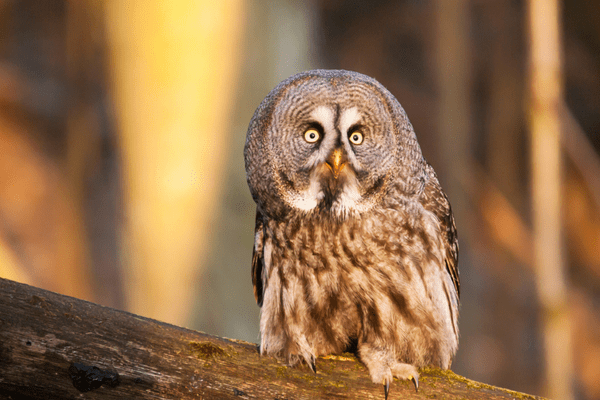
Great grey owl threats
The Great Grey Owl has a Least Concern conservation status. This means that the population is currently stable and it isn’t under a potential threat to become endangered. In fact, it’s estimated that there are anywhere between 50,000 to 100,000 mature owls of this species and their numbers seem to be increasing today.
Great grey owl fun & interesting facts
- This owl species is incredibly popular amongst birdwatchers. In fact, birdwatchers seem to like this owl the best out of every possible owl to choose from. It’s easy to spot these owls during the breeding season, which takes place between March and August each year.
- The adult Great Grey Owl does have natural predators. Their natural predators include the Black Bear, Broad-Winged Hawk, Northern Goshawk, Common Raven, Great-Horned Owl, Golden Eagle, and Lynx.
- The 1918 Migratory Bird Treaty Act in the US protects many birds including the great Grey owl from being hunted. Hunters are no longer allowed to kill them to steal their eggs or feathers. They initially enacted this act to protect migratory birds because hunting practices were leaving many bird species endangered.
- The Great Grey Owl is fierce and powerful and an incredibly strong predator. This is especially true while protecting their nest. Because of their size and extreme ferocity, while threatened, they are capable of driving off the largest of predators including black bears.
- Great Grey Owl outlets typically attempt to fly for the first time between 4-6 weeks of age. At this time, they will begin developing their coordination skills as they finally learn how to fly. It gives them the opportunity to explore and stretch their wings and discover the excellent hunting opportunities within the territory. Typically, these young owls can stay airborne for 10 minutes before they need to land and take a rest.
- Barred Owl
- Short-Eared Owl
- Western Screech-Owl
- Northern Saw-Whet Owl
- Northern Pygmy-Owl
- Flammulated Owl
- Boreal Owl
- Snowy Owl
- Elf Owl
- Long-Eared Owl
- Spotted Owl
- Burrowing Owl
- Northern Hawk Owl
- Eastern Screech-Owl

